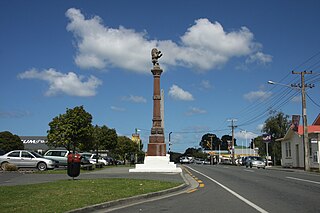
Ground beetles are a large, cosmopolitan family of beetles, Carabidae, with more than 40,000 species worldwide, around 2,000 of which are found in North America and 2,700 in Europe. It is one of the ten most speciose animal families, as of 2015.
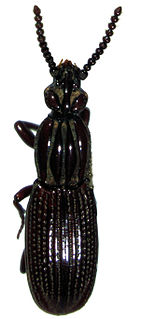
Rhysodidae is a family of beetles, consisting of more than 350 species in about 20 genera.

Adam White was a Scottish zoologist.
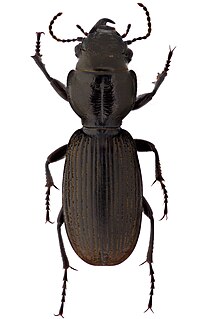
Mecodema oconnori is a ground beetle of the family Carabidae, endemic to New Zealand. It is up to 40 mm in length, and is found mainly in the North Island, but also in the South Island at Kaikoura.

Bountya insularis is a species of beetle in the family Carabidae, the only species in the genus Bountya. Both the genus and species was first described by J. I. Townsend in 1971 from specimens collected by E. G. Turbott on Bounty Island on 11 November 1950. The holotype specimen is in the entomology collection of the Auckland War Memorial Museum.
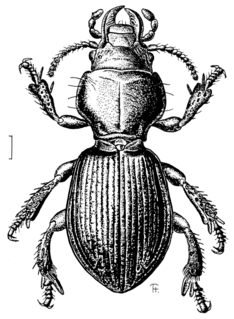
Brullea antarctica is a carnivorous carabid beetle, the only species in its genus, that burrows in sand above the high tide mark on New Zealand beaches. Both the genus and species were first described by Francis de Laporte de Castelnau in 1867.

Maoripamborus fairburni is a species of beetles in the family Carabidae, the only described species in the genus, though there are some reports of an additional undescribed species. The genus is endemic to northern North Island in New Zealand, and is most closely related to the Australian genus Pamborus.
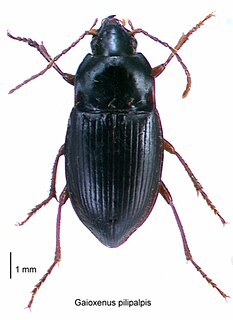
Gaioxenus is a genus of beetles in the family Carabidae. Gaioxenus pilipalpis is the only species in the genus. This genus and species was first described by Thomas Broun in 1910. Broun based the descriptions on specimens he collected in Raurimu in the Manawatu-Wanganui region of New Zealand. Gaioxenus pilipalpis is endemic to New Zealand.

Holcaspis is a genus of beetles in the family Carabidae, endemic to New Zealand.

Plocamostethus is a genus of beetles in the family Carabidae. It is endemic to New Zealand. The genus contains the following species:
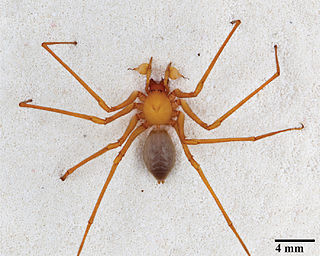
Trogloraptor is a genus of large spiders found in the caves of southwestern Oregon. It is the sole genus in the family Trogloraptoridae, and includes only one species, Trogloraptor marchingtoni. These spiders are predominantly yellow-brown in color with a maximum leg span of 3 in (7.6 cm). They are remarkable for having hook-like claws on the raptorial last segments of their legs.
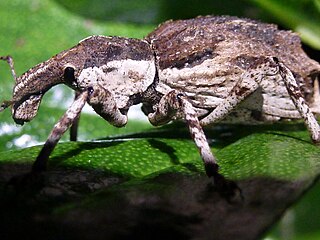
Anagotus stephenensis, commonly known as the ngaio weevil, is a large flightless weevil that is only found on Stephens Island in New Zealand. The ngaio weevil was discovered in 1916 by A.C. O'Connor on Stephens Island. Thomas Broun described it in 1921 as Phaeophanus oconnori after its collector. The weevils were observed at the time to be 'feeding on tall fescue and the leaves of trees'.
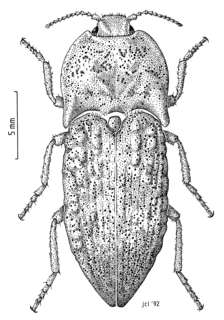
Amychus granulatus, commonly known as the Cook Strait click beetle, is a large flightless click beetle in the family Elateridae.
Merlin Owen Pasco was a New Zealand entomologist. Pasco discovered several species of moth previously unknown to science and collected numerous specimens.
Ptomaphagus cavernicola is a species of small carrion beetle in the family Leiodidae. It is found in Central America and North America.

Holcaspis brevicula, the Eyrewell ground beetle, is a species of carabid beetle native to New Zealand, one of a number of small black flightless beetles in the genus Holcaspis that inhabit the dry eastern lowlands of the South Island. H. brevicula is very rare—only ten specimens have ever been collected—and critically endangered: the species was found only in Eyrewell Forest, a single plantation of exotic pine trees currently being converted into dairy farms.
Mecodema atuanui was described from a single male specimen collected in pitfall traps on Mt Auckland, Kaipara Region. It is a medium-bodied ground beetle that is related to Mecodema spiniferum, which is the only large-bodied ground beetle species found in the Waitakere Ranges, Auckland, rather than the more geographically close species to the east in Puhoi.
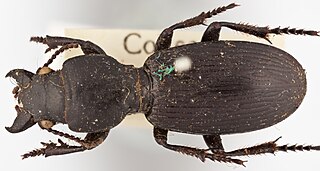
Mecodema curvidens Broun is a medium-bodied ground beetle that geographically widespread throughout the central areas of the North Island,New Zealand, which includes the entomological regions of Auckland (AK), Waikato (WO), Coromandel (CL), Bay of Plenty (BP), Taupo (TO), Rangitikei (RI), Whanganui (WI), Hawkes Bay (HB) and Wellington (WN). Recently, the species M. occiputale Broun was synonymised under M. curvidens. Mecodema curvidens is relatively common through its range except in the Auckland and Wellington regions.
Mecodema quoinense is a large-bodied ground beetle of the genus Mecodema, an endemic New Zealand carabid, which is found in the Tararua Ranges, North Island above about 1000 m. It is named after the type locality Mount Quoin, but specimens have been found on Mount Holdsworth. This species is in Britton's spiniferum group and can be distinguished from other Mecodema species by the very distinctive shape of the male genitalia.

